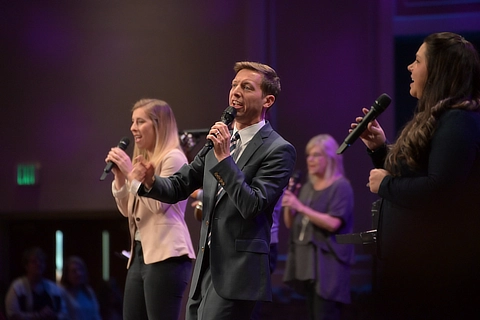
In this final blog on planning and leading healthy congregational worship, we will consider the importance of engaging all generations in the worship life of the church. When we refer to multiple generations, we are speaking of those who can engage in corporate worship from the youngest to the oldest. The discussion of engaging all generations in worship brings forward the very nature of the church and who can participate in worship.
For centuries, even millennia, congregations have included entire families in worship. There is also biblical precedent for this, so I would encourage churches to seriously consider the ramifications of removing young people from the full congregation.
Over the past thirty to forty years, we have seen a trend of removing children from the corporate worship gathering and assembling them in a child-oriented/focused gathering (children’s church, kids worship, etc.). Churches have attempted to focus more pedagogically on children’s spiritual growth and development as well as that of their parents by tailoring the message and method in age-appropriate ways. While I certainly see the value of this approach, this is still a relatively new development in the lifespan of the Church.
The statistics on teenagers and young people leaving the church have shown a steady incline throughout almost the entire time that we have been taking them out of worship with the full congregation. To speak bluntly, we should not be surprised that our children are leaving the church in their teenage and young adult years when we have just spent the past thirty years telling them not to worship with the Church.
So, how can we turn the tide and bring all generations to worship together in community? This comes with various challenges, for sure, especially as one considers a myriad of other priorities like church growth, missional service, and high-level worship service production. We also carry the weight and influence of cultural trends that emphasize and curate a “user-experience” based on generational preferences. However, despite these challenges, we must reorient our priorities to value generational fusion in worship, reuniting children with their families whether in the pew or on the platform.
But not only children…we must consider how many churches have sidelined our senior citizenry by forgetting them, or worse, ignoring them. In many cases, these individuals are the source of substantial spiritual wisdom, church institutional knowledge, and financial stability for congregations. Where children are worthy of our time and attention, our senior members are worthy of honor and distinction.
Let’s first consider how we can engage all generations in worship.
Content:
Plan worship content that is familiar or connectional for all ages. You might not be able to do this each week, but consider how to do this over the course of a month. Include music that connects with and communicates to younger and older generations. Again, this will likely not be every week, but can you try to do this over the span of a month?
Consider if highlighted themes/ideas and sermons speak to the needs/questions of children, students, and all adults? How can you empower parents to take ownership for discipling their children/teenagers and guiding their spiritual growth? If you make announcements or share prayer needs, are those reflective of all ages in your church? Do the analogies/examples used in a sermon reflect the perspective of the youngest to the oldest?
Method and Manner:
Is your church friendly and accessible to families with young children? Without advanced and intentional planning and preparation, it comes across that the accommodation of children (and senior adults) is a nuisance or inconvenience. Consider the following:
- Is the preschool/child check-in process clear and streamlined, with volunteers to greet and assist?
- Are safety procedures clear, communicated, and followed?
- Is security nearby, whether in uniform or plain clothes?
What about for the elderly?
- Is worship accessible for those who might use a walker or wheelchair? Is there senior adult parking? Do you have volunteers to greet and assist in the parking lot and at entrances?
- Do you have hearing-assisted devices for those with hearing impairment?
- Can you devise a hallway walking path from parking to bible study room to worship that keeps senior adults on one level or near an elevator?
In Worship:
- Are theological truths presented in ways that are accessible for children? Some churches incorporate a “children’s moment” that conveys a simple truth in a way suitable for children, while others offer children a packet containing different tools and manipulatives to engage them in worship in child-friendly ways.
- Is the music singable by anyone from a young child to a senior adult? This means it needs to be in a singable key and the pace/speed/rhythm of the lyrics is manageable.
- Is the sound level at risk of damaging children’s hearing? I know churches that hand out noise cancelling headphones for families with young children as they enter the worship space. This is quite concerning. What does that say about our priorities in corporate worship?
Lastly, consider how to engage all generations in worship leadership.
Find ways to incorporate children up to senior adults in leading various elements of the service.
All ages could help with:
- Praying (1st/2nd grade+)
- Reading scripture (3rd/4th grade+)
- Leading the welcome/announcement time (teenagers)
- Leading a solo or verse of a hymn or worship song (3rd grade+)
- Playing an instrument before or during worship (teenagers+)
- Serving on welcome/greeting/first impressions teams (5th grade+)
- Serving as ushers (teenagers+)
- Singing on an all-generations vocal team (4th/5th grade and up)
I have seen a few more substantial approaches that require additional work and programming. Examples include:
- Children and Student Choirs
- Senior Adult Choirs
- Intergenerational Choir (likely 5th grade and up; either weekly, seasonal, or project-to-project basis)
- “All-Generations” Sunday that has all ages coming together to form a mass choir (children through senior adults) to lead in worship.
As I consider these ideas, I’m reminded that while it may be challenging to bring all generations together in worship, I believe ultimately that this is God’s design for worship. We don’t need to be trendy or overly creative to do this. We simply must be intentional. Let’s bring the whole of God’s people together, young and old, in worship.
This is the final article in an eight-part series on Vital Signs for Healthy Corporate Worship. Additional articles include:
Worship Check-up: Vital Signs for Healthy Congregational Worship
Healthy Congregational Worship—Is Trinitarian in Nature
Healthy Congregational Worship—Encourages Vibrant Congregational Singing
Healthy Congregational Worship—Is Planned and Prepared
Healthy Congregational Worship—Activates Vertical and Horizontal Relationships
Healthy Congregational Worship—Is Timely and Timeless
Healthy Congregational Worship—Remembers its Context and Community

Jonathan P. Rodgers is Area Coordinator of Music and Worship, Director of the Samford Worship Collective, and Faculty Fellow for The Center for Worship and the Arts at Samford University. He has been directing choirs in schools and the church for over twenty years. As a clinician and presenter, Rodgers has been a guest conductor for honor choirs throughout the Southeast. Currently, he is serving as Minister of Music and Worship at Liberty Park Baptist in Birmingham, Alabama. Prior to this position, Rodgers was Minister of Music and Worship Arts at Hunter Street Baptist Church, and prior to that, Assistant Professor of Choral Music at Lee University in Cleveland, Tennessee. In addition to his conducting and scholarly activities, Jonathan is an active pianist, composer, and arranger. Jonathan has been married to his wife Alicia for twenty-one years, and they have four children: Savannah, Leighton, Brooks, and Gabe.
